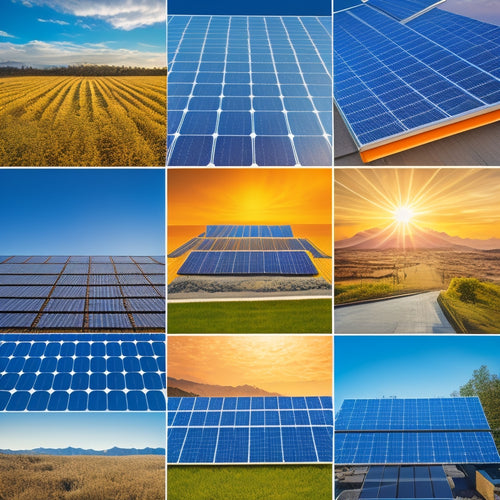
Switching to Solar Power for a Sustainable Business
Share
You're taking a notable step towards a sustainable future by switching to solar power, a move that can meaningfully reduce your business's environmental footprint and energy costs. By understanding your energy needs, you can choose the right system, optimize energy efficiency, and utilize incentives and financing options to make the shift more affordable. From federal tax credits to state incentives, there are various opportunities to offset the initial investment. As you investigate the benefits of solar energy, you'll learn how to measure your sustainability impact and maximize the ROI of your switch – and that's just the beginning of your solar expedition.
Key Takeaways
- Assessing energy needs through energy audits and usage patterns is crucial for determining the right solar system size and configuration.
- Solar energy can significantly reduce energy costs over time, with federal tax credits and state incentives available to offset initial investment costs.
- Energy efficiency opportunities, such as lighting and HVAC upgrades, can optimize energy usage and enhance the effectiveness of solar technologies.
- Choosing the right solar system type, installation size, and panel quality is critical for maximizing energy production and reducing maintenance costs.
- Tracking carbon footprint and establishing sustainability metrics can help measure the environmental impact and ROI of switching to solar power.
Benefits of Solar Energy
The shift to solar power is driven by numerous benefits that make it an attractive option for businesses seeking to reduce their environmental footprint. You can greatly reduce your energy costs with solar power, resulting in substantial cost savings over time. By switching to solar, you're also minimizing your environmental impact, as solar energy is a clean and renewable resource. This means you'll be reducing your reliance on fossil fuels and decreasing your carbon emissions.
In addition to cost savings and environmental benefits, solar power provides energy independence, reducing your reliance on the grid and protecting you from price fluctuations. As a long-term investment, solar energy systems can provide a stable source of power for years to come.
Furthermore, solar power supports grid reliability by reducing peak demand and providing energy storage capabilities. The growth of the solar industry also leads to job creation and community support.
With ongoing technological advancements, solar energy is becoming increasingly efficient and affordable, making it an attractive option for businesses seeking a sustainable future.
Assessing Your Energy Needs
You'll need to understand your energy usage patterns, including the times of day and year when you use the most energy, to determine the size of the solar panel system you require.
You should also calculate your current energy costs to compare them with the costs of switching to solar power.
Additionally, identifying energy efficiency opportunities in your business can help you optimize your energy usage and maximize the benefits of solar power.
Energy Usage Patterns
Often, businesses overlook an essential step in shifting to solar power: understanding their energy usage patterns.
To accurately assess your energy needs, you must identify your peak usage periods, consumption trends, and potential energy storage requirements.
This involves analyzing your energy usage data to determine when you need the most power and how you can optimize your energy storage systems to meet those demands.
Current Energy Costs
Having analyzed your energy usage patterns, you're now ready to assess your current energy costs. This step is essential in determining the financial benefits of switching to solar power.
Take a closer look at your past utility bills to understand your energy expenditure. Identify the peak consumption periods, and note the corresponding costs.
Consider the following factors that influence your current energy costs:
-
Utility rate fluctuations: How have your utility rates changed over time? Are they fixed or variable?
-
Energy market trends: Are there any shifts in the energy market that could impact your costs?
-
Seasonal variations: Do your energy costs differ markedly between summer and winter?
-
Time-of-use rates: Are you charged differently for energy consumption during peak and off-peak hours?
-
Demand charges: Are you penalized for high peak demand periods?
Energy Efficiency Opportunities
As you investigate the world of solar power, it's vital to evaluate your energy needs and identify areas where you can optimize energy efficiency. This involves analyzing your current energy usage patterns, identifying energy-intensive systems, and determining opportunities for improvement.
Conducting an energy audit is an effective way to do this. During an audit, a professional will evaluate your building's energy usage, identifying areas of inefficiency and providing recommendations for improvement. This may include upgrading to energy-efficient lighting, installing smart thermostats, or optimizing HVAC systems.
By implementing these measures, you can reduce your energy consumption, lower your energy bills, and create a more sustainable business operation. Additionally, optimizing energy efficiency can also increase the effectiveness of renewable technologies, such as solar power, by reducing the amount of energy needed to power your business.
Choosing the Right System
You've narrowed down the benefits of switching to solar power and are now ready to choose the right system for your business. This decision is vital, as it will impact the efficiency and cost-effectiveness of your solar power installation.
When selecting a system, consider the following key factors:
-
System types: Grid-tied, off-grid, and hybrid systems each have their advantages and disadvantages. Grid-tied systems are the most common, but off-grid systems may be suitable for remote locations.
-
Installation size: The size of your installation will depend on your energy needs and available roof space. A larger installation may not always be the best option, as it may not be fully employed.
-
Panel quality and efficiency: High-efficiency panels may be more expensive, but they can provide more power per unit area.
-
Inverter type: String inverters, microinverters, and power optimizers each have their own strengths and weaknesses.
-
Monitoring and tracking capabilities: A system with real-time monitoring and tracking capabilities can help you optimize energy production and identify potential issues.
Installation and Maintenance
Proper installation and maintenance are crucial to guaranteeing your solar power system operates at its highest level of performance. You'll want to choose a reputable installer who can assess your energy needs and design a system that meets those needs. They'll handle the installation process, which typically takes a few days to a few weeks, depending on the size of your system.
Once installed, you'll need to maintain your system to make certain it continues to perform at its best. This includes regular cleaning of your solar panels, which can be done every 6-12 months, depending on the location and type of panels. You'll also want to monitor your system's performance regularly to identify any potential issues.
Here's a breakdown of typical maintenance schedules for different solar panel types:
| Solar Panel Type | Maintenance Schedule |
|---|---|
| Monocrystalline | Every 6 months |
| Polycrystalline | Every 12 months |
| Thin-Film | Every 3 months |
Incentives and Financing Options
You'll be pleased to know that switching to solar power can come with significant financial benefits.
You're eligible for federal tax credits, which can cover a substantial portion of your solar installation costs.
Additionally, you may be able to take advantage of state incentives and examine various financing options to make your shift to solar power even more affordable.
Federal Tax Credits
As businesses shift to solar power, they can greatly benefit from federal tax credits, which play an essential role in offsetting the initial investment costs.
These credits can considerably reduce the financial burden of moving to renewable energy, making it a more accessible option for businesses of all sizes.
When it comes to federal tax credits, you can expect:
- A 26% tax credit on the total cost of your solar panel system, allowing you to claim a considerable portion of your investment back
- The ability to claim tax deductions on the depreciation of your solar panel system, further reducing your taxable income
- Federal rebates that can be combined with other incentives to maximize your savings
- No cap on the amount of credits you can claim, making it an attractive option for large-scale solar installations
- A 5-year carryback and 20-year carryforward period, giving you flexibility in when you claim your credits
State Incentives Available
Beyond federal tax credits, businesses can tap into state-specific incentives to further reduce the cost of switching to solar power.
You'll find that many states offer additional incentives to encourage the adoption of renewable energy sources. These state programs can provide significant funding sources to help offset the initial investment in solar panels and installation.
Some states offer rebates or grants to help cover the upfront costs of solar installation.
Others provide property tax exemptions or sales tax exemptions on solar equipment.
You may also find states that offer performance-based incentives, such as feed-in tariffs or renewable energy certificates, which can provide a steady stream of revenue based on the amount of electricity your solar system generates.
Financing Options Exist
Solar-powered businesses can employ a range of financing options to overcome the upfront costs associated with switching to renewable energy.
You don't have to bear the burden of high initial costs alone. There are various financing options available to help you shift to solar power.
-
Crowdfunding solutions: Platforms like Kickstarter or Indiegogo can help you raise funds from a large number of people, making it easier to finance your solar project.
-
Leasing options: You can lease solar panels from a third-party provider, reducing your upfront costs and providing a fixed monthly payment plan.
-
Power purchase agreements: Similar to leasing, you can enter into a power purchase agreement, where a third-party provider installs and maintains the solar panels, and you purchase the electricity generated at a fixed rate.
-
Community solar: You can partner with other businesses or individuals to invest in a community solar project, sharing the costs and benefits of renewable energy.
-
Tax credits and grants: Federal and state governments offer tax credits and grants to encourage businesses to switch to solar power, reducing your overall costs.
Measuring Your Impact
Measuring Your Impact
You've made the switch to solar power, but how do you quantify the positive impact it's having on your business and the environment? Measuring your impact is essential to understanding the effectiveness of your sustainability efforts. Start by tracking your carbon footprint, which is the total amount of greenhouse gas emissions produced by your business operations. This will give you a baseline to work from and help you identify areas for improvement.
To get a thorough overview, you'll want to establish sustainability metrics that go beyond just carbon emissions. This could include metrics such as energy savings, water conservation, and waste reduction.
By regularly tracking and analyzing these metrics, you'll be able to see the tangible benefits of your solar power investment and make data-driven decisions to further reduce your environmental impact.
With concrete numbers in hand, you'll be able to communicate your commitment to sustainability to stakeholders, customers, and employees, enhancing your brand reputation and contributing to a more sustainable future.
Frequently Asked Questions
Can I Install Solar Panels on a Rented Property?
You'll need to review your rental agreements and obtain your landlord's permission before installing solar panels on a rented property, ensuring you understand any restrictions or requirements for modifications to the property.
How Do I Ensure System Performance During Power Outages?
Like a lighthouse guiding in the dark, you'll want a reliable system during power outages; to guarantee this, you'll need to prioritize system maintenance and invest in energy storage solutions, like batteries, to keep your lights shining bright.
Are There Any Specific Certifications for Solar Installers?
You'll want to look for solar installers with certifications from programs like NABCEP or UL, which verify their installer qualifications, ensuring they meet industry standards for safety, efficiency, and quality.
Can I Sell Excess Energy Back to the Grid?
Savvy sustainability seekers, you'll delight in finding out that, yes, you can sell excess energy back to the grid through net metering benefits and energy buyback programs, which allow you to offset your utility bills and even earn credits.
How Long Does a Typical Solar Panel Warranty Last?
You'll typically find that a solar panel warranty lasts around 25 years, covering defects and guaranteeing a minimum solar panel lifespan of 80% capacity during that time, with some manufacturers offering extended warranty coverage.
Conclusion
As you flip the switch to solar power, you'll be utilizing the energy of a thousand suns to fuel your business. It's a move that's not only good for the planet, but also your bottom line. With the right system in place, you'll be reaping the benefits of renewable energy in no time. So, take the first step towards a brighter, more sustainable future – and let the sunshine in on your business.
Related Posts
-

Top-Rated Solar Storage Solutions for Homeowners
When considering top-rated solar storage solutions, you're looking at systems that provide energy independence and si...
-

Evaluating Solar Power Options for Businesses
Evaluating solar power options for your business can greatly reduce energy costs and enhance sustainability. Start by...
-

Comparative Analysis of Top Solar Brands
To conduct a comparative analysis of top solar brands, focus on key metrics like durability, energy efficiency, and s...


